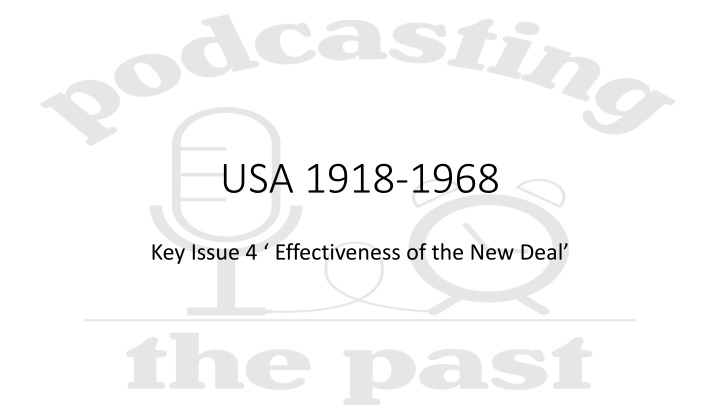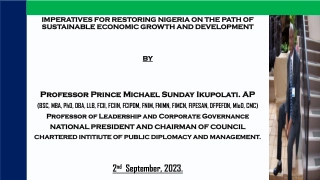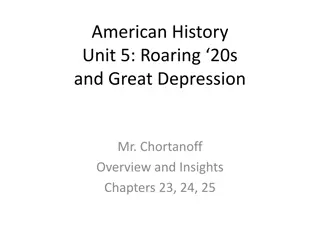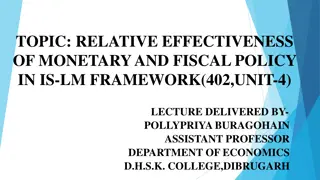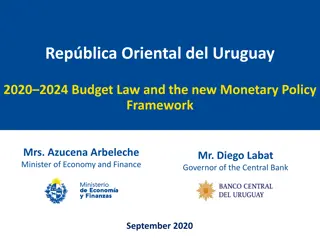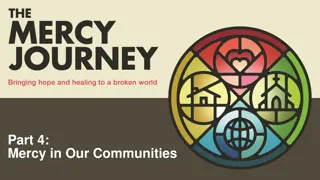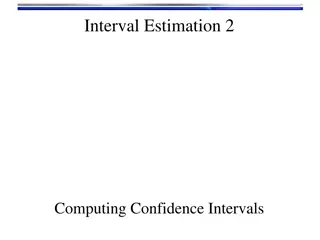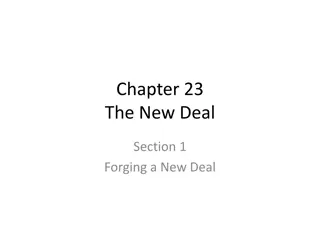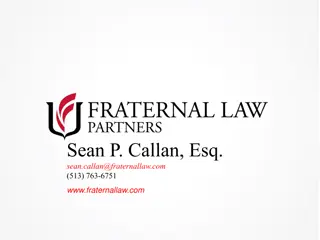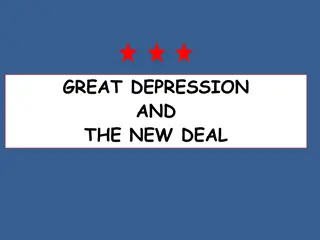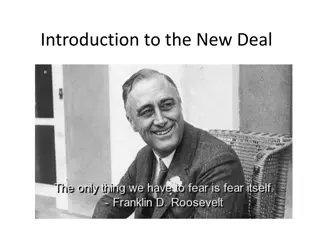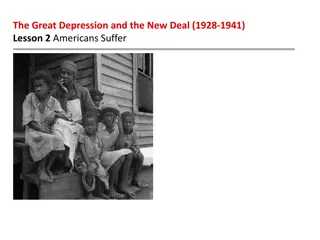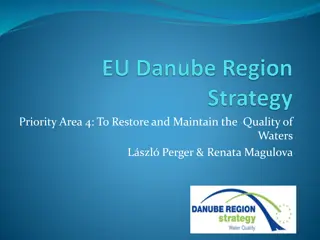Effectiveness of the New Deal in Restoring Confidence and Addressing Economic Problems
In the context of the USA during 1918-1968, the New Deal implemented by President Franklin Roosevelt was aimed at addressing the devastating effects of the Great Depression. By restoring confidence in the banking system through measures like the Emergency Banking Act and engaging with the public through fireside chats, Roosevelt initiated key programs such as Social Security Act, Banking Act, and National Labor Relations Act. This interventionist approach helped in stabilizing the economy, providing relief, and laying the foundation for long-term effects on economic recovery.
Download Presentation

Please find below an Image/Link to download the presentation.
The content on the website is provided AS IS for your information and personal use only. It may not be sold, licensed, or shared on other websites without obtaining consent from the author.If you encounter any issues during the download, it is possible that the publisher has removed the file from their server.
You are allowed to download the files provided on this website for personal or commercial use, subject to the condition that they are used lawfully. All files are the property of their respective owners.
The content on the website is provided AS IS for your information and personal use only. It may not be sold, licensed, or shared on other websites without obtaining consent from the author.
E N D
Presentation Transcript
USA 1918-1968 Key Issue 4 Effectiveness of the New Deal
Factors 1. Restoring Confidence 2. First New Deal: Relief and Economy Recovery 3. Second New Deal: Social Problems 4. Long Term Effects Economic Problems
Context In 1933, the USA was in a terrible situation: 12 million unemployed; over 1 million homeless; the banking system had all but collapsed and many argue America was near revolution They needed someone to blame Democrat Franklin Roosevelt faced an enormous task in attempting to solve the Depression of the 1930s His solution was known as the New Deal He focused on a more interventionist approach
New Deal Timeline 1935: Social Security Act 1933-34: Fireside Chats 1935: Banking Act 1933: FERA 1933: PWA 1939: Manufacturing 1933 TVA 1933-37: Unemployment 1933: Emergency Banking Act 1933: Economy Act 1935: National Labor Relations Act
Restoring Confidence Knowledge (BG)The first 100 days of Roosevelt s administration began with the use of Broad Executive Power e.g. didn t need to go through Congress to pass acts (K1) To do this he passed The Emergency Banking Act of March 1933 (K1) Roosevelt declared a 4 Bank Holiday during which banks were inspected to see if they had sufficient funds - those that were ruined were shut down or merged (K2) The four day bank holiday gave time for Roosevelt to persuade people to leave their money in the bank with his fireside chats (K2) Here he used the radio to explain the situation & his intentions of the New Deal over 30 radio shows between 1933-1934.
Restoring Confidence Analysis This was successful in dealing with America s problems because (A1) By saying this, FDR was telling the American people that their fear was making things worse - by running to the banks and taking their money out they were causing more damage to the economy! (A1) Instead they needed to trust the banks & most importantly BUY GOODS to kick start the economy (e.g. tax & jobs)! (A1) It reformed the banking system (A1) Restored faith as straight away people were putting money in rather than withdrawing (A2) Millions listened to him & felt his confidence and willingness to communicate with the public showed that he was worth supporting & trusting as he tried to make big changes to the way the Federal Government supported ordinary Americans e.g. move away from Laisse-Faire to increased government intervention (A2) The public sent letters of their support to the White House which made it easier for him to pass policies (A2) Their increased confidence was shown through bank deposits immediately exceeding withdrawals & generally spending more money which helped to improve the US economy
Restoring Confidence Analysis Plus Overall, some Historians argue that the ND was successful because (A+1) It helped to restore confidence through regulation which in return helped to recover the economy because people started to spend again. However, other Historians argue that (A+1 it had failed to provide relief for the most needy, those living in poverty. (A+2) However, all was not solved it wasn t until 1935 & the establishment of the Federal Bank Deposit Insurance Corporation was set up that people s bank deposits (up to $5,000, and later, $10,000) were insured and therefore secure
First New Deal: Relief and Economy Recovery Knowledge (K1) The Economy Act, 1933 (K1) The Economy Act (March 1933) raised $1 billion by cutting Government & armed services pay by 15% & reduce payments to veteran s pensions = that could be used to provide relief (K2) FERA (Federal Emergency Relief Act), 1933 (K2) FERA (Federal Emergency Relief Administration, May 1933) provided $500 million to set up soup kitchens & provide clothing for those most affected by the Depression (K3) TVA (Tennessee Valley Authority) 1933 (K3) The TVA (Tennessee Valley Authority, May 1933) aimed to stop flooding along the Tennessee River (some of the most impacted regions by the depression) by building dams & hydro-electric power plants. (K3) PWA (Public Works Administration) $3.3 billion toward building schools & hospitals (K3) Perhaps the most successful agency was the PWA (Public Work Administration June 1933) - it provided millions of jobs through public building schemes such as hospitals; schools & roads. These projects which would be of long-term benefit to the community.
First New Deal: Relief and Economy Recovery Analysis This was successful in dealing with America s problems because (A1) Used to create the Alphabetical Agencies (A1) That would create jobs across America (A2)This was extremely important as it was the first time that the US government had acknowledged that they should help the needy (laisse faire to interventionist approach) (A3)This was successful in dealing with America s problems because (A3) This provided cheap power and 1,000 s of jobs in construction across 16 states!
First New Deal: Relief and Economy Recovery Analysis Plus (A+3) However these work schemes only helped people with a skill - unskilled labourers were not catered for to the same extent under the New Deal (perhaps why unemployment never dipped below 8 million) (A+3) However it also put many small electrical firms out of business which was the reverse of what the New Deal desired
First New Deal: Relief and Economy Recovery Evaluation Overall, some Historians argue that the ND was successful because (EV) It provided relief for those in poverty for the first time & started to tackle the problems with the economy through work drives. However, other Historians argue that (EV) Also, during this time of hardship racial discrimination increased to the extent where some public work programs refused to hire Blacks & even had different pay scales! However, with 75% of Black voters supporting the Democrats shows their spending programs must have been improved their daily lives. (EV) Nevertheless he was re-elected four times which is an indicator of his popularity with the public
Second New Deal: Social Problems Knowledge (K1) National Labor Relations Act, 1935 (K1) The Wagner Act, also known as the National Labor Relations Act (NLRA) was passed by Congress, signed into law by President Roosevelt coming into effective on July 5, 1935. New York Senator Robert F. Wagner introduced the legislation, hence the name of the Wagner Act. (K1) It protected the rights of workers through collective bargaining with their employers via Trade Unions & had 9 million members by 1938 in the private sector! (K2) The Social Security Act of 1935 was set up as a form of National Insurance this is where the profits of employers and the tax of employees went to help subsidised state benefits e.g. the government still funds some (K2) In this for the sick; retired; child & unemployed as well as grants for the blind (K2) The thinking behind this act was that pensions would withdraw older Americans from the work force to free up jobs for younger workers
Second New Deal: Social Problems Analysis This was successful in dealing with America s problems because (A1) It was a major step forwards reforming America (Republicans) (A1) It also strengthen the power of organised labour as they could demand better wages & conditions (A1) It legalised strikes if the employees and employer were unable to reach an agreement over for working conditions concerning: "wages, hours, and other terms and conditions of employment." (A1) The NLRA represents one of the landmarks of federal legislation its greatest social contribution was the opportunity AND responsibility it gave to employees to organise themselves and to determine/administer the law (A2) reform America by creating for the first time a benefit system (A2) Which tries to tackle inequality in wealth
Second New Deal: Social Problems Analysis Plus (A+1) However, not all workers were covered by this Act, such as agricultural workers & women earned on average only half the wages of men, whilst racial discrimination also still occurred.
Second New Deal: Social Problems Evaluation Overall, some Historians argue that the ND was successful because (EV) It reformed the previous governments approach to welfare, by providing a safety net for those in need as well as stopping worker being exploited. However, other Historians argue that (EV) However, many felt it didn t go far enough - was a wasted chance to go further and set up more of a welfare state e.g. health care (EV) In addition, many groups weren t covered: farm workers & self employed. Also, pensions were only paid to a certain qualifying group of people: 65 years old & made at least $2,000 the year before retirement!
Second New Deal: Economic Problems Knowledge (K1) Employment: between 1933 &1937 the number of people unemployed in the USA decreased from 14 million to 8 million, so the New Deals work drives did appear to have worked. (K1) Lowering unemployment meant that people could then participate in the economic activity of purchasing consumer goods and increasing demand an employment. (K2) Manufacturing: Roosevelt s first term as president (1933-1936) saw one of the fastest periods of GDP (Gross Domestic Product - the monetary measure of the market value of all final goods and services) growth in US history: (K2) GDP increased by 60% from $55 billion to $85 billion & private investment in industry increased by 5 times in just six years! (K2) By 1939 production had returned to the level of 1929 with the amount of consumer products bought increasing by 40%!
Second New Deal: Economic Problems Analysis However, this certainly did not solve America s problems because (A1) Ultimately, the New Deal did not put an end to the problem of unemployment: (A1) 1 in 4 people (25%) were unemployed at the beginning of the New Deal and 1 in 5 (20%) were still unemployed when it ended (A1) It was never at any point below 14% (A2) It only began to fall steeply again in 1939 when the USA began to build up its armaments in case of war which led to huge increases in jobs in industry. (A2) Was Hitler more to thank for ending the Great Depression?
Second New Deal: Economic Problems Evaluation Overall, some Historians argue that the ND was successful because (EV) In the short term it provided recovery within the economy as unemployment & manufacturing was restored. However, other Historians argue that (DE) The problems that America faced were too big to be tackled by the New Deal reform in such a short period.
